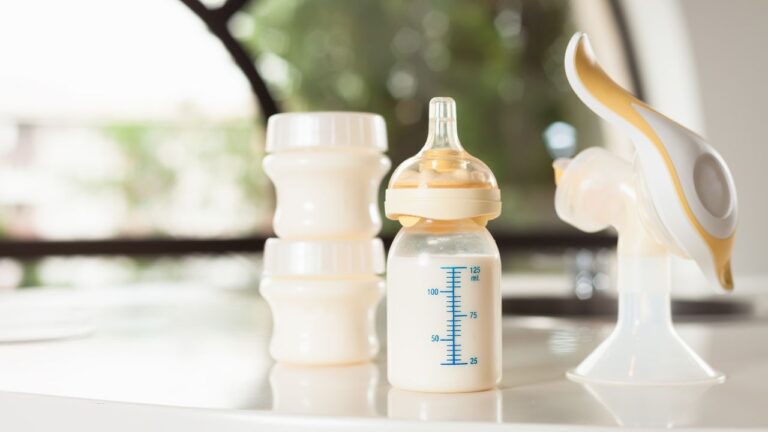Best Wearable Breast Pump for Pumping on the Go: Willow vs. Elvie
This post may contain affiliate links and we may earn commissions when you make a purchase through these links (at no extra cost to you). See our disclosure policy for more details.
Pros and Cons of Two Wireless, Hands-Free Breast Pumps
Do you frequently find yourself pumping on the go? If you’re running after a rampant toddler or pumping on your commute to work, and you need to free up your hands, then you’ll want only THE BEST wearable breast pump.
Willow® and Elvie are two of the most popular wearable pumps because they are wireless, meaning you can truly pump “on the go”.
But is one any better than the other? Today, we’re going to compare and contrast the two and figure out which is the better choice for you.

Why a Wearable Breast Pump?
Breastfeeding and breast pumping are hard work, there’s no way around it. So if there’s something that can help make it even a little bit easier, that’s a no-brainer in my book.
But first, is there any reason why you shouldn’t invest in a wearable breast pump?
Personally, I feel it wouldn’t be worth the expense if you are exclusively breastfeeding and don’t plan on pumping much. Because, let’s face it, they’re expensive.
If you only need to pump every once in a while to help relieve a clogged milk duct or to leave some milk with an occasional caregiver, then an inexpensive manual or electric pump (whatever your insurance covers) should do the job.
But if you’re exclusively pumping, combination breastfeeding and pumping, or have to return to work and need a good pump that allows you the freedom to do other things while expressing milk, then I really think you’ll love having a wearable breast pump.
I remember how stressful it was being stuck next to the outlet, holding my breath and hoping my baby (or toddler) wouldn’t have a meltdown mid session. And, frankly, I hardly ever pumped when I was at home, mainly because I didn’t need to.
But I honestly can’t imagine how hard it is to exclusively pump for a little one — especially while running after bigger kids. (If that’s you, then way to go, mama!)
And that’s where the wearable, wireless pump comes in.
Let’s talk about the pros and cons of wireless pumps as well as how to use them, and then we’ll get into the nitty gritty of Willow and Elvie.
Wearable Breast Pump Pros and Cons
What are the pros and cons of wireless, wearable breast pumps? Let’s take a quick look.
Pros
- They are easy to use and the parts are dishwasher safe.
- You place it inside your nursing bra, and your hands are free to do other things while the pump does all the work.
- If it’s wireless, you can freely move around — you don’t have to plug it in.
- They are typically quieter than a standard electric pump.
- You should be able to use HSA/FSA funds to pay for it (if insurance doesn’t cover it).
Cons
- There are a couple more parts to clean than a standard pump.
- You have to make sure they’re charged BEFORE you need to pump.
- It doesn’t necessarily yield as much milk as a standard pump, especially if you don’t get a good “latch”.
- The bluetooth connection can be spotty and measurements aren’t always accurate.
- They’re definitely on the expensive side.
- They’re not necessarily spill-proof.
How to Use a Wearable Breast Pump
You’ll want to follow the detailed instructions that come with the pump you choose, but here’s a quick rundown of how to use a wearable, wireless breast pump.
1. First of all, make sure it’s charged. For your safety, you won’t be able to pump while it’s charging — keep in mind that it will likely take a couple hours to fully charge.
2. Attach a milk bag to the pump if you’re using a Willow. (With Elvie, you just pump directly into the bottles.)
3. Press the power button to turn the pump on.
4. Open your nursing bra and make sure the fabric is out of the way. Bring the pump to your breast, and use the instructions provided with your pump to ensure correct alignment. (Follow the instructions carefully; correct alignment is key!)
5. Follow the instructions provided with your pump to initiate latch.
6. Once your pump is in stimulation phase, close your bra, making sure it is snug enough to hold the pump in place. If it’s too snug, Elvie has bra adjusters that help create a little extra space.
7. You can pause or adjust suction levels as needed during the pumping process.
8. When you’re done pumping, you’ll need to “flip to finish” if using a Willow. Then turn the pump off and remove the milk bag (or empty the bottle if using Elvie).
9. Clean your pump parts according to the manufacturer’s instructions.
Willow
Here’s what you need to know about the Willow wireless breast pump.
- you can either use disposable collection bags or a reusable milk container
- it holds up to 4 ounces of milk per breast
- you can pump while lying down
- 24 and 28 mm breast shields are included, and 21 mm can be purchased separately
- there are 7 suction levels
- you can operate it manually or through a free app
- it’s BPA-free and the parts are dishwasher safe
- the battery takes 2 hours to fully charge and lasts up to 5 sessions
- use the “flip to finish” function when done pumping
Click HERE to check on current Willow pricing… Or click HERE for everything you need to know about how to use Willow Pump.
Elvie
And here’s what you need to know about the Elvie wireless breast pump.
- it’s a little more discreet with a thinner profile than Willow (5 in x 4.3 in x 2.7 in)
- you pump directly into a milk collection container
- it can hold up to 5 ounces of milk per breast
- it’s easier to use than Willow
- the battery takes 2 hours to fully charge and lasts 2.5 hours (depending on intensity)
- 24 and 28 mm breast shields are included, and 21 mm can be purchased separately
- there are 7 suction levels
- you can operate it manually or through a free app
- it’s BPA-free and the parts are dishwasher safe
- there’s a 2-year warranty on the Hub and 90 days for the washable parts
Click HERE to check on current Elvie pricing.
Best Wearable Breast Pump for Pumping on the Go
So, which is better, the Elvie or Willow?
While it holds slightly less milk, Willow allows you the ability to move around more or even lie down if you want to. On the other hand, Elvie has a slightly more discreet profile if you want to pump in public, and it’s a little easier to use.
Their features are otherwise pretty similar and the pricing is comparable between the two, so you really can’t go wrong with either one.
Which will you go with? Have you tried one of these wireless breast pumps? I’d love to hear your thoughts in the comments!
Read more:
5 Ways to Discreetly Breastfeed in Public (Without a Nursing Cover)
5 Must-Have Products: What to Buy Before Breastfeeding
Best Advice for a New Parent: Readers Share Their Favorite Parenting Tips








What a super helpful post! My son is no longer drinking breast milk, but when he did I exclusively pumped and this information would have been invaluable.
Way to go! That’s a BIG job, so you did awesome! Even though I only pumped occasionally, it still felt like so much work….
Does one work better than the other with a plus size chest?
Hi Krysta! Thanks for asking. While the Willow is slightly larger in size than the Elvie, they were both designed for all different breast sizes. Also, I’d like to note that they both come in three different breast shield sizes to accommodate different nipples sizes. Hopefully that helps!